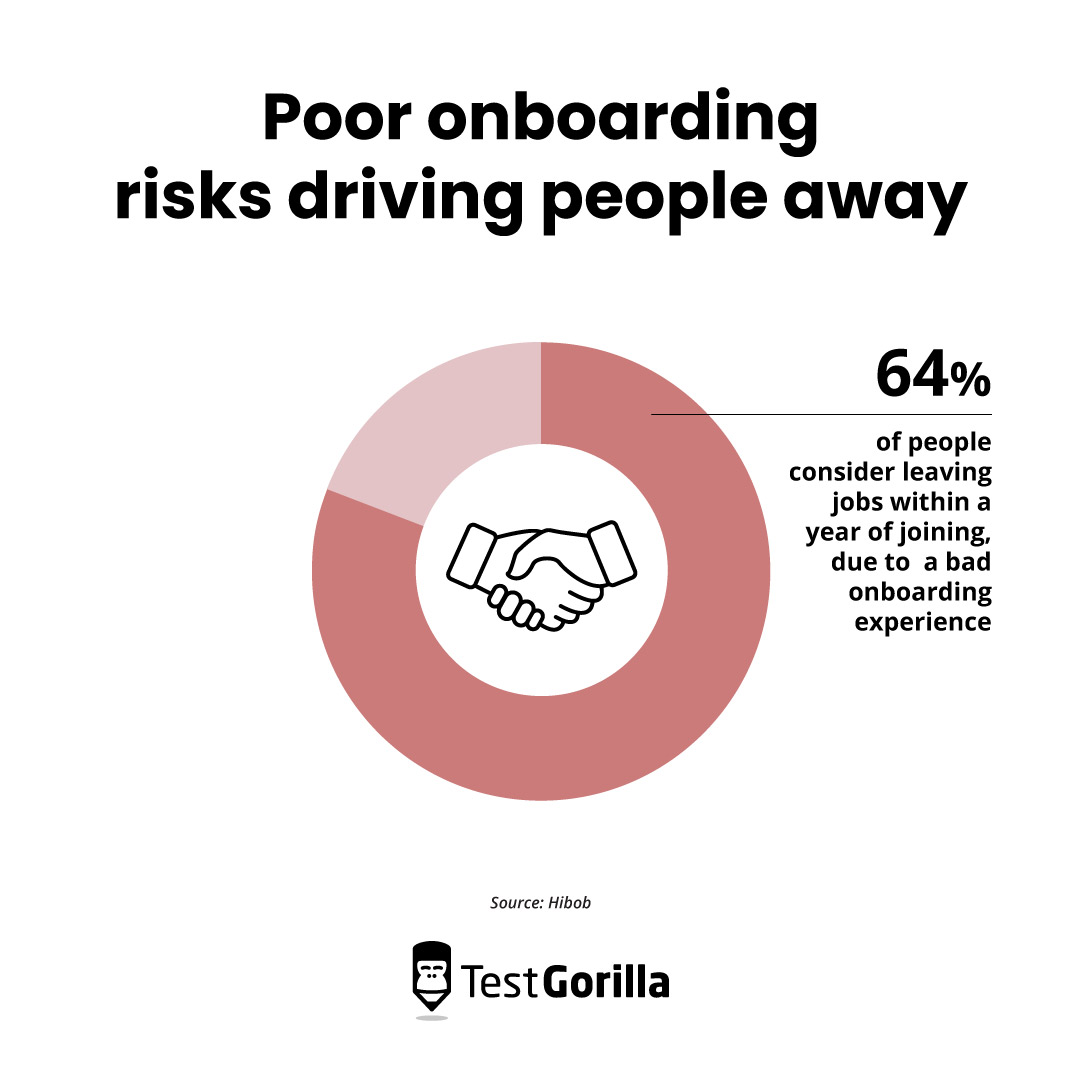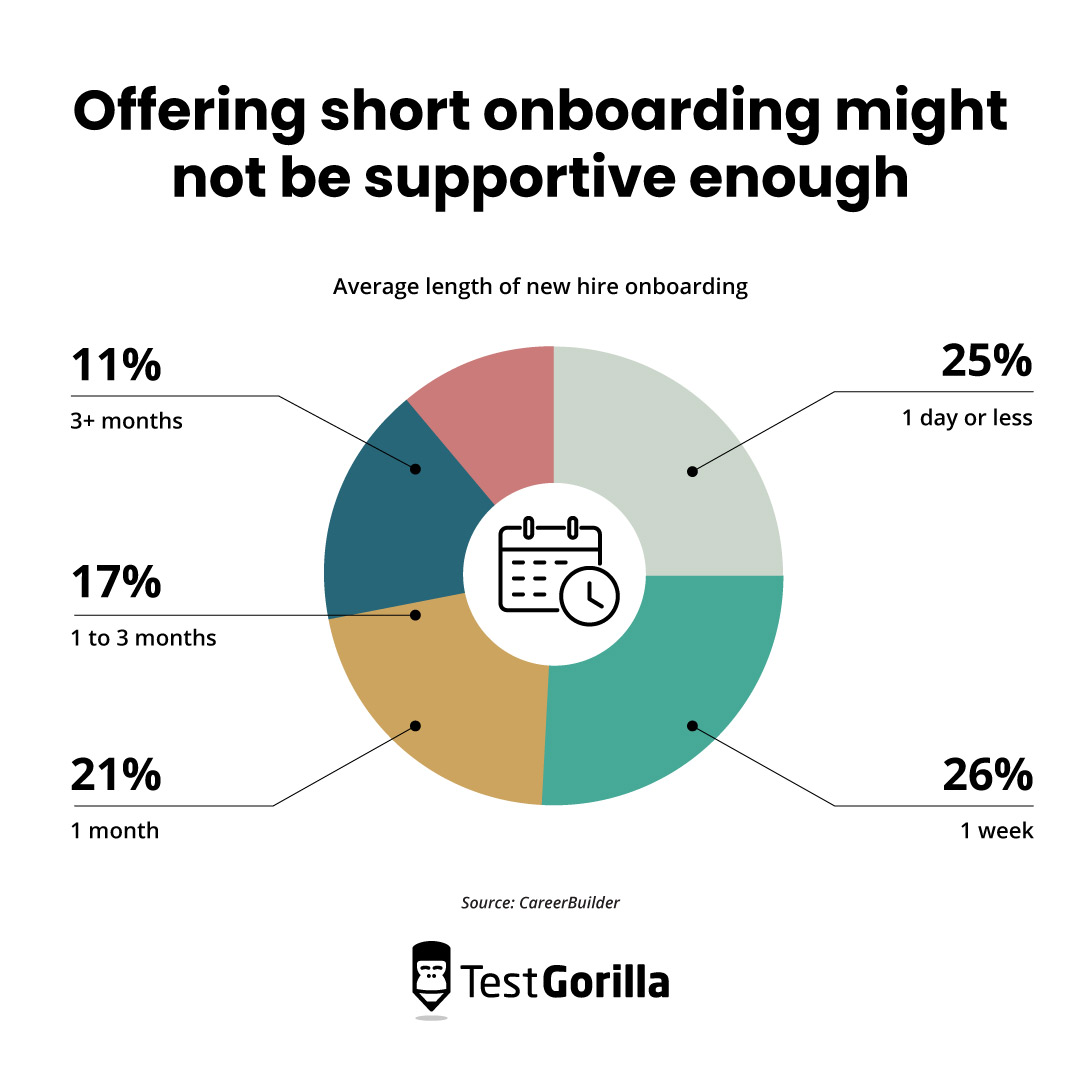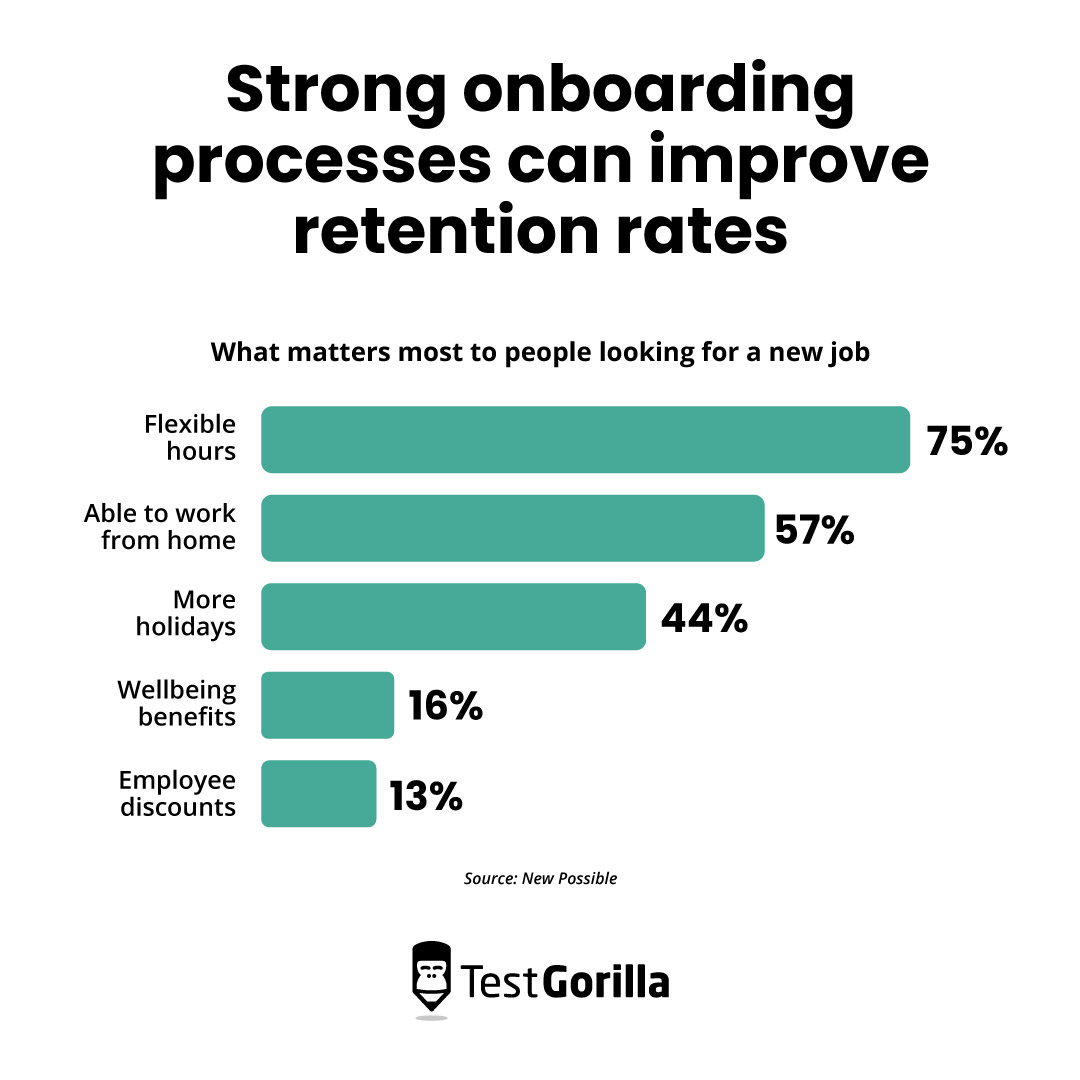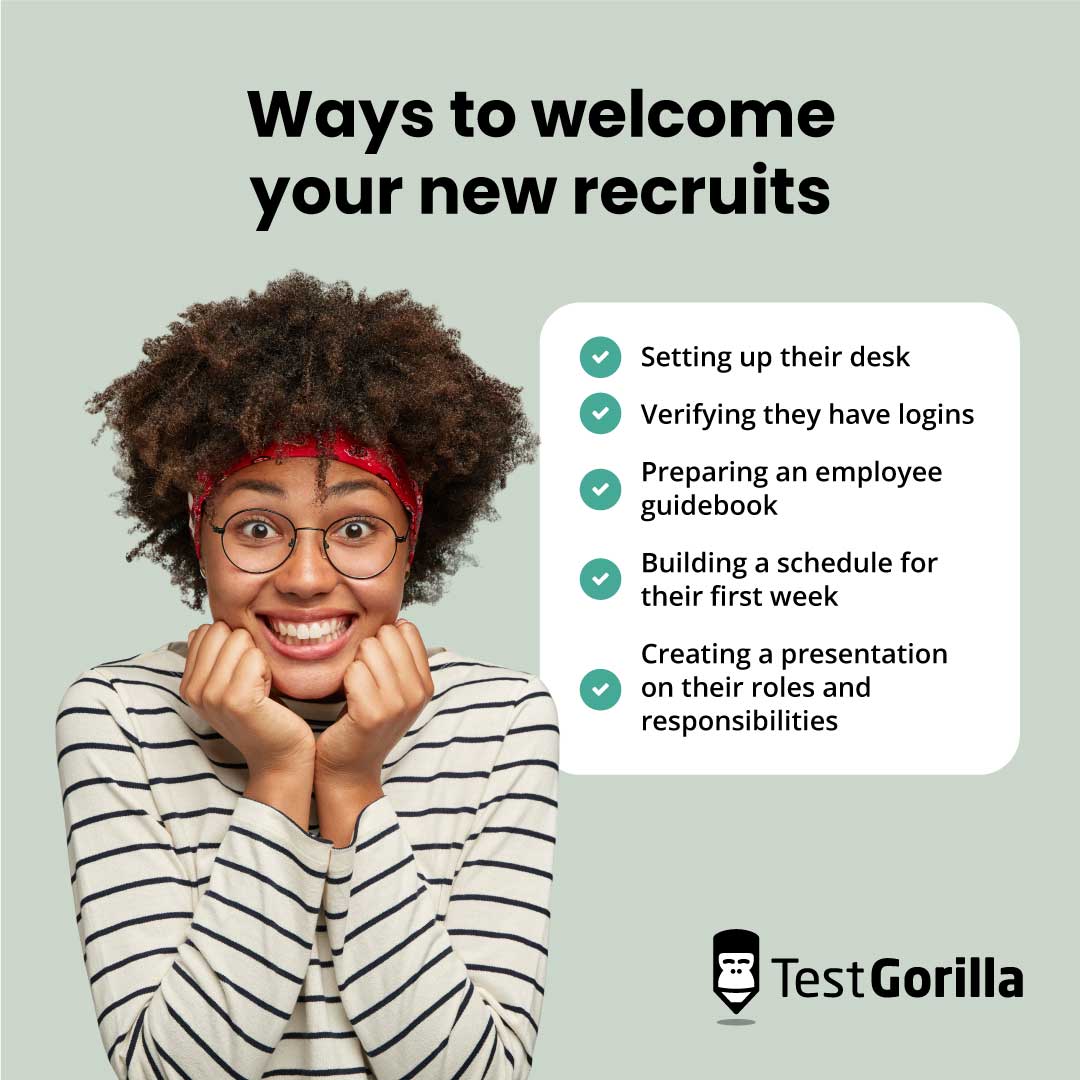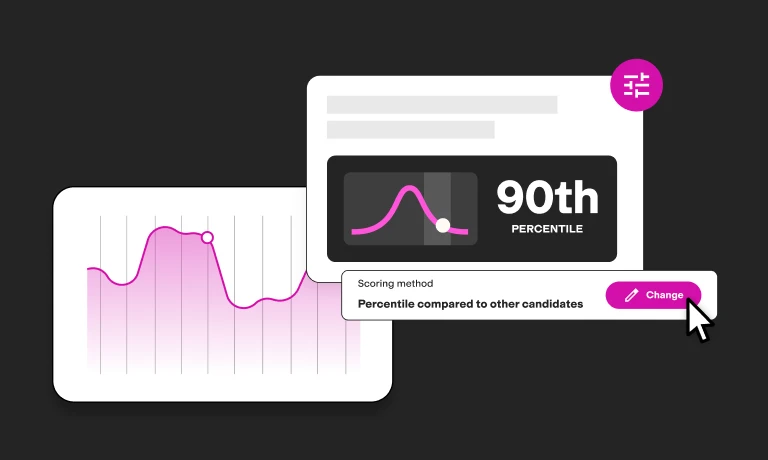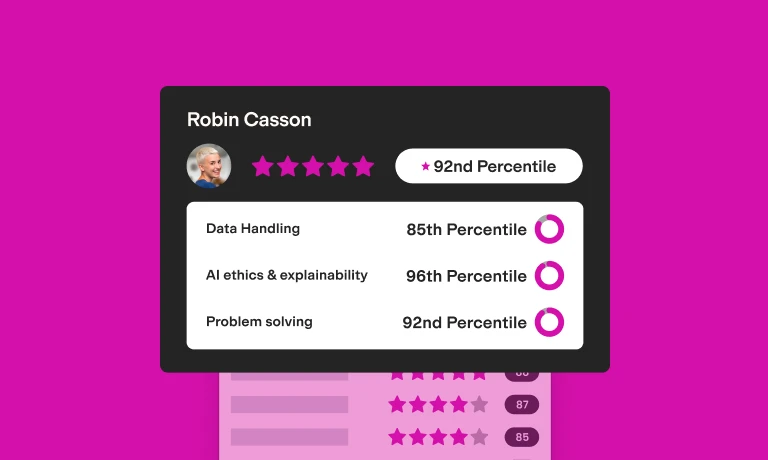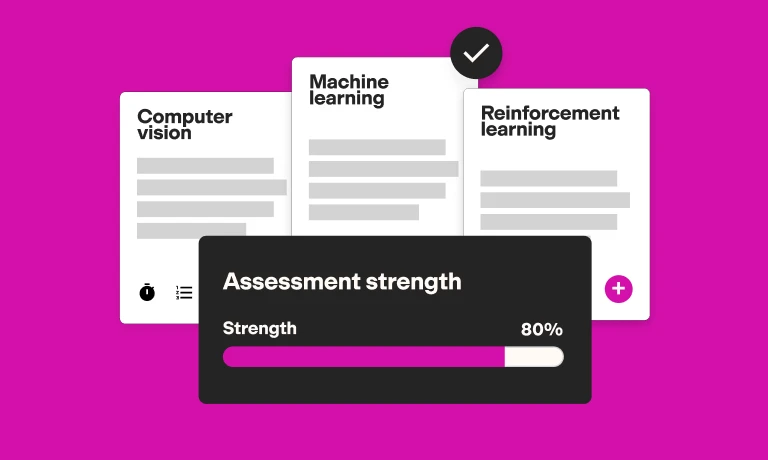Onboarding process: How to leverage this talent retention strategy and wow new recruits
First impressions matter, and the best way to welcome new recruits is with a supportive onboarding experience.
However, getting onboarding poorly risks driving people away. Up to 64% of people consider leaving jobs within a year of joining – purely because they had a bad onboarding experience.[1]
What’s more, 72% of millennial and Gen Z workers have regretted joining companies because they failed to deliver on promises.[2]
People quit shortly after onboarding because they:
Feel isolated and unsupported
Lose trust in their employers
Struggle with poorly defined responsibilities
A positive onboarding process can turn a quick quitter into a great culture add hire who stays with you for years to come.
In this guide, we show you how to turn those first few weeks and months into an ironclad employee retention strategy.
Table of contents
- What is an onboarding process?
- Why is the employee onboarding process important?
- The benefits of a strong onboarding process
- 11 best practices for leveraging a great onboarding process to retain your best performers
- 3 examples of companies succeeding with good onboarding processes as a talent retention strategy
- Build an onboarding process that inspires top talent to stay
What is an onboarding process?
An employee onboarding process is a series of steps you take to help recruits settle into your company and learn more about their responsibilities.
For example, an onboarding process for new hires might include:
Completing new hire paperwork
Arranging meetings with supervisors and colleagues
Creating employee training programs
Setting up coaching sessions
Assigning mentors
Drawing up a professional development plan
Having a robust onboarding process is a strategy that goes hand in hand with talent retention trends like flexible working and job rotation, both of which you can promote during onboarding.
The length of time it takes to onboard employees can vary by company. However, most companies spend less than three months in the process.[3]
Only 11% of companies onboard employees for longer than three months:
Given that it takes employees up to a year to reach full productivity in a new role, those companies offering shorter onboarding might not be supportive enough.[4]
Moreover, given the statistics regarding employee turnover and bad onboarding experiences, it makes sense to buck this trend to support your recruits better because only 29% of people feel they get enough support during onboarding.
We look at the benefits of onboarding a little further down.
The stages of the onboarding process
Here are some typical stages that explore the role of HR in the onboarding process:
Stage | Things included |
1. Hiring | - Assessing skills via interviews - Running background checks - Sending job offer letters |
2. Preboarding | - Sending welcome emails - Providing employee handbooks, company policies, FAQs, and employee benefits information - Setting up timetables, logins, and paperwork |
3. The first day | - Welcoming recruits - Starting employee orientation with insights into the company, including premises tours - Supplying schedules |
4. The first weeks and months | - Training and check-ins with employees - Outlining upskilling opportunities - Getting feedback from co-workers and managers |
5. End of year one | - Checking in with a one-year review - Asking for feedback about the company and its processes |
Why is the employee onboarding process important?
According to SilkRoad and CareerBuilder, 68% of job seekers judge a company based on its hiring experience.[5]
If your onboarding process lacks support and clarity, people expect the same problems to persist during their tenure with you.
On the other hand, converting on your promises boosts your employer branding – positive word of mouth travels fast.
Listening to your recruits and being clear on their responsibilities makes you something of a rarity. Only 12% of people think their companies do a good job onboarding.[6]
By delivering an effective onboarding process, you start delivering on your EVP, or employee value proposition.
For example, if you promise internal mobility and lateral promotions to a successful recruit, you could start providing details on how to develop and access roles within their first year.
Positive onboarding experiences help employees feel more welcomed, supported, and confident about the work ahead.
Plus, recruiters and HR professionals benefit from clear hiring plans and onboarding processes they can confidently follow without distraction.
The best insights on HR and recruitment, delivered to your inbox.
Biweekly updates. No spam. Unsubscribe any time.
The benefits of a strong onboarding process
Strong onboarding processes benefit everybody, but let's break down some of the tangible perks.
Retention and loyalty improve
According to Gartner, up to 82% of people want human validation from their companies. Yet 45% feel their employers miss the mark.
A tailored onboarding experience shows each recruit your company values their skills, personality, and contributions. You should always prioritize employee recognition during and after onboarding – after all, people stay with employers who show they value them from the start.
Research backs this up: Strong onboarding processes can improve employee retention rates within a company by up to 82%.[7]
A strong onboarding program also increases loyalty by delivering on promises right away. For example, employees increasingly seek out flexible work opportunities, office perks, and wellbeing benefits:[8]
Delaying or holding back promises, such as the perks listed above, makes hires feel like they've made a mistake joining your company and can lead to quick quitting.
Employees integrate easier
Research shows that 89% of employees feel effective onboarding helps them feel engaged at work. Moreover, they're 30 times more likely to feel satisfied with their jobs.[9]
Showing people who they’re working with, the tools to use, and who they can contact for help boosts employee engagement and confidence and offers a sense of belonging.
An onboarding process that includes new recruits in social events (like a team lunch) and feedback sessions helps an employee feel like a member of the team sooner.
Poor onboarding leaves employees to their own devices, which can result in people feeling removed, potentially leading to quiet quitting.
Performance and productivity improve
Bringing recruits closer to the heart of your company boosts productivity. This is because encouraging recruits to integrate early helps them get up to speed and work to their full potential.
Getting to know colleagues plays a big part in employee productivity: 22% of people believe they're more productive when they work alongside friends.[10]
Productivity improves through positive onboarding because employees have opportunities to make stronger connections. They know who to approach if they need help and have a clearer understanding of the supply chain.
Personal development programs offered as part of onboarding help employees focus on the bigger picture and inspire them to work toward future career growth.
11 best practices for leveraging a great onboarding process to retain your best performers
We’ve selected and broken down 11 tips you can use across the five onboarding process steps to inspire loyalty and employee satisfaction from the best people in your business.
The stages break down chronologically, so they’re easy to follow as you plan and carry out your onboarding program.
Want to dive deeper into employee onboarding?
Read our complete guide. It’s packed with tips, step-by-step strategies, and industry insights —to build a seamless employee onboarding plan.
How to make the most of your onboarding process steps
Onboarding process steps and tips | Quick breakdown |
Stage 1: Hiring | |
Create accurate job descriptions | Create clear expectations for hires to help them feel confident in their roles and your promises |
Make hiring as smooth as possible | Follow up with candidates regularly to show you care about their applications and to keep them engaged |
Use recruiting automation and technology | Cut down on hiring time and admin hours by delegating and streamlining tasks – making hiring more accurate and preventing applicant ghosting |
Stage 2: Preboarding | |
Make preboarding personal | Reassure recruits with a preboarding experience tailored to their specific needs – ease first-week nerves and show them you care |
Support virtual preboarding for remote employees | Create a more inclusive process by taking preboarding online – appeal to remote employees and broaden your talent pool |
Stage 3: The first day | |
Prepare for recruits to arrive | Set up employees’ workspaces, logins, and tools to help ease them into your team |
Assign buddies | Identify team members that hires can shadow to build their first working relationships and boost confidence and productivity |
Stage 4: The first weeks and months | |
Show you value recruits’ opinions | Gently encourage hires to give insight in meetings and invite them to social events, helping them integrate and build confidence |
Focus on team building | Arrange team-building exercises to encourage communication and cohesion and foster productivity |
Stage 5: End of year one | |
Measure and monitor onboarding metrics | Check retention and turnover rates, test scores, and punctuality to measure if you have an effective employee onboarding plan |
Meet with recruits to discuss their first year | Ask recruits for feedback at the end of year one so you can share honest opinions on the process and how they’ve performed |
Tips for stage 1: Hiring
A supportive onboarding process starts with a job description because this is where you make your first impression.
1. Create accurate job descriptions
Accurate job descriptions give your recruits extra confidence, so be comprehensive but concise.
Consider listing the skills your employees need in the role and the responsibilities to expect on an average day.
Applicants want to know about your company culture as early as the job ad, too. In fact, 71% of job seekers value these details when choosing what to apply for.[11]
The best idea, therefore, is to manage expectations. Step one of a successful onboarding process is to be open and honest with recruits. By doing so, you cut the risk of them feeling overwhelmed or disappointed.
Try to lean into job descriptions that revolve around skills and responsibilities. List essential competencies for roles and explain how you use them, making it clear what you test for before interviewing.
You could find out more about the skills your roles demand by testing your existing workforce. For example, if you find your best-performing administrators score highly in project management skills tests, make a point to hire for that skill in the job description.
Beyond this, consider using talent assessment software that suggests skills tests for specific roles. For instance, here are the assessments we recommend for an accounting assistant:
If you have upskilling and reskilling programs, make sure to let applicants know after listing your preferred skills for the role.
2. Make hiring as smooth as possible
It pays to make your hiring process clear and structured so applicants know what to expect.
Long and complex processes give the impression that your company is disorganized and cares little about individual needs.
Research shows that 27% of candidates aged 18 to 34 ghost or quit hiring processes because they take too long. The same study confirms that 18% of the same group quit because the recruiter wasn't transparent enough, and 15% were confused about what to do next.[12]
So, keep their interest and follow up regularly to inform applicants about the next steps.
Consider putting candidates at the heart of the process by giving them your complete attention – you should make them feel appreciated before you even offer a job.
Then use skill assessments to promote transparency. Show applicants their results and what these mean in the context of working for you.
You could then share test results with unsuccessful applicants to inspire development and keep them in your talent pipeline for future drives.
3. Use recruiting automation and technology
Using the right onboarding software stack helps you save time on repetitive hiring tasks and spend more of it engaging with candidates.
Household names such as Electrolux, the appliance manufacturer, adopt AI-powered recruitment technology to combat talent shortages.
Since adopting AI and automation, the company has decreased time-to-hire by 9%, saved 78% more time through scheduling, and even boosted applicant conversions by 84%.[13]
As Electrolux shows us, recruiting automation and AI can help you bring people on board quicker, reducing the likelihood of talent ghosting you for better opportunities.
For instance, automation through technology like candidate relationship managers helps you keep track of applicant conversations. Using this software, you could automate hiring process updates and let applicants book interview dates to suit them.
You can use skill assessment software to build test templates for you based on specific job profiles, too:
Consider automating rejection responses so applicants know where they stand. Later on, you might reach out to them during passive recruiting drives, and they might remember you were willing to give them closure.
Studies note around 55% of people find application rejection ghosting frustrating. Always update applicants regardless of the outcome to maintain a positive employer brand.[14]
Tips for stage 2: Preboarding
Preboarding is an important step between someone accepting a job offer and getting started with you. Here are some tips to try before an employee's first day.
4. Make preboarding personal
People want to feel like individuals, so personalize each preboarding process.
Many people feel scared and apprehensive when starting a new job, regardless of their talent. Only 11% of people feel comfortable after a week of settling into a role, and 53% of employees claim starting a new job is scarier than visiting the dentist![14]
Therefore, make a point to gently welcome employees so they settle in and trust you before their start date.
You could invite candidates for private tours of your premises if applicable. Send tailored care packages as a welcome, filled with their favorite brands or treats.
From there, think carefully about an appropriate "buddy" your recruit can shadow. We cover this in its own section below.
Above all, personalize the emails you send to preboarding hires and draw on what you discussed in interviews. Don't fall back on cold-form responses.
5. Support virtual preboarding for remote employees
Dare to go beyond the office because many preboarding activities can take place offsite.
For example, you can share information about your company, send care packages, and confirm important details without meeting in person.
Think about leaning into a virtual onboarding process to appeal to remote employees, a large cross-section likely to take up 22% of the US workforce by mid-decade.
A virtual onboarding process helps you stay flexible and appeal to as many people in your hiring pool as possible. It supports a fully inclusive hiring process because you don’t lock out people unable to work on-site, such as people with disabilities, working parents, or students.
To start, you could schedule virtual meetings and deliver digital presentations people can watch and interact with from afar.
Then supply remote logins and links to software new team members can download to access your tools.
Tips for stage 3: The first day
Many employees are apprehensive about what to expect on their first day in a job – so help them settle in and encourage loyalty with these top tips.
6. Prepare for recruits to arrive
You should always wow your recruits by ensuring everything's ready when they arrive.
Get started by creating an onboarding checklist or similar templates to give your hires everything they need to settle in and get started.
Consider welcoming your recruits by:
Setting up their desk
Verifying they have logins
Preparing an employee guidebook
Building a schedule for their first week
Creating a presentation on their roles and responsibilities
You could follow the lead of companies such as Accenture, the tech consultancy giant, which preboards two weeks ahead with personalized welcome packages before a complete day-one orientation of what to expect from the company.[15]
7. Assign buddies
To ease people into their roles, make it clear to hires who they can contact if they need help, and break down the duties of people in the command chain.
You could assign “buddies” to recruits based on their roles and skills. To ensure you match up compatible people, consider using personality assessments:
Doing so helps support hires’ social integration and ensures they have someone to rely on when starting out. It’s a good way to help hires build their first working relationships. Companies that thrive on the buddy system include Microsoft, which found employees were happier in their roles and more productive after onboarding.[16]
Tips for stage 4: The first weeks and months
At this stage, your recruits are getting into their first projects, but you still have opportunities to support their integration.
8. Show you value recruits’ opinions
People don’t want to feel like the newbie for long – they want to feel included, supported, and valued.
Therefore, show recruits that their insights and skills genuinely matter. For instance, start by inviting them to social events and feedback sessions.
To create safe meeting spaces, make it clear that you want to hear from everyone onboard.
A 2023 survey found that up to 46% of people lack the confidence to speak up and communicate effectively at work post-pandemic. You must make these people's voices heard with a supportive atmosphere from the get-go.[17]
9. Focus on team building
Creating team-building exercises to include hires ensures they don't feel isolated. Studies claim isolation can reduce productivity by up to 21%.[18]
Exercises and workshops help people get to know each other better and learn about their skills and insights. Socializing accounts for more than 50% of positive communicative change in the workplace.[19]
So, focus on creating fair and inclusive exercises that enable everyone to contribute equally.
For example, create an icebreaker session where everyone gets a chance to answer open questions:
If you were an animal, which would you be and why?
“What’s the best advice you’ve ever received?”
“What would you do with an extra hour per day?”
Open-ended icebreakers are remote-friendly, too, making them some of the most inclusive activities.
Tips for stage 5: End of year one
Here are some ideas to help you leave a positive mark on a recruit's first year.
10. Measure and monitor onboarding metrics
At the end of each recruiting year, check onboarding data and HR analytics to measure process success.
For instance, dig deep into metrics such as:
Employee turnover rate and retention rate
Ramp-up time
Skills test scoring
Attendance and punctuality
Employee performance
All of these metrics can help you make changes to your new employee onboarding process. For example, if you have a high bounce rate and employee flight risk remains high, you might need to improve engagement.
Moreover, low attendance, punctuality, and performance could indicate you're not doing enough to support your employees' learning and development – or you have mis-hired, meaning it could be worth considering a skills-first onboarding system.
Always reach out for specific feedback from employees, too. Create a questionnaire and ask how people feel about the onboarding process and how it could be improved.
11. Meet with recruits to discuss their first year
Getting an employee to the end of a year is a positive result. They are likely engaged, but it's always worthwhile asking for insight and feedback.
Invite recruits to one-on-one meetings and ask them openly about their experiences at the end of year one.
Are there any areas of support you could improve? What elements of onboarding did they dislike, if anything?
At the same time, carefully review their performance. Could you have supported them better to produce higher-quality results? In return, be open and candid about how you feel they've performed.
Employees want to know the truth. If they’ve underperformed, give them closure and suggest ways you could develop and mentor them.
Then offer clear next steps. Refer to their professional development plans and discuss opportunities within the company for learning, development, and lateral movements.
3 examples of companies succeeding with good onboarding processes as a talent retention strategy
Some of the biggest companies worldwide foster loyalty and trust thanks to positive, supportive onboard programs.
Let’s look at three onboarding success stories to help inspire your own.
Onboarding process example cases
Company | Onboarding process example |
Zapier | Produces personalized documents and encourages “learning through doing” to gradually welcome people into its workforce |
FORUM | Creates fun, themed exercises around its core principles and processes to engage better with recruits |
MaidPro | Produces video content to show off its work environment, enticing recruits and assuring them of what to expect |
Zapier
In recent years, Zapier, a workflow automation company, gradually integrated engineering employees by providing personalized documents that lay out exactly what they can expect from their first few weeks.[20]
As a remote-first company, the brand emphasizes the importance of clear communication by helping recruits understand its collaboration tools, setting expectations, and answering questions using highly detailed guides.
By week two of its engineering onboarding, the firm encouraged people to start "learning by doing," gradually increasing the complexity of tasks as they build confidence.
By the end of the month, employees were encouraged to meet up physically for team-building socials to help instill company culture.
This onboarding process helps retain employees because it covers lots of detail within a short period but drip-feeds information without overwhelming people.
FORUM
FORUM, a financial services provider, focuses on fun. It redesigned its initial onboarding process because stuffy paperwork aligned poorly with its true culture.[21]
Instead, the company introduced a weeklong program called "Connections." This program presented a series of games designed to welcome hires into the company based on team-building and financial skills.
For example, the firm ran a tongue-in-cheek spin on "Project Runway" called "Project FORUMWay." It's an onboarding event that asks staff to choose what they believe to be appropriate outfits from a rack before facing a panel of judges.
The company's games have helped people understand its products and encourage teamwork in fun and surprising exercises.
In fact, the firm stated this onboarding structure has supported retention, with people wanting to replay the games even years into employment.
MaidPro
MaidPro, a housecleaning provider, switched its onboarding focus to video content to engage better with candidates.
The company offers a library of videos to show people its culture instead of telling them details second-hand. The visual media helps to immerse recruits before they get started.[22]
The firm uploads fun videos showing recruits what they can expect from social events and team-building games and offers introductions to existing employees.
This approach shows employees the brand cares about them and consciously avoids stuffy, overcomplex documentation and guides.
This multimedia strategy helps hires see what they can expect from the company long-term, alleviating worries and generating excitement about what’s to come.
Build an onboarding process that inspires top talent to stay
A positive employee experience should start as soon as someone applies to work with you. After all, your onboarding process offers a window into how you support workers in the long run.
A good onboarding process that's exciting and supportive shows applicants you're serious about the promises you make during recruitment.
Follow through on these promises, and you can expect to hire talented people who will stick with your organization.
While you’re refining your onboarding process for new hires, we recommend reading our guide on retaining talent with a more inclusive culture.
Then kick-start a skills-focused approach to employee retention with inspiration from our test library.
Sources
1. Hodkin, Shayna. (November 10, 2020). “What’s the connection between onboarding and retention?”. Bob. Retrieved October 23, 2023. https://www.hibob.com/research/hibob-research-finds-64-of-new-hires-leave-a-job-after-a-bad-onboarding-process/
2. Tomb, Devin. (August 30, 2022). “72% of Muse Survey Respondents Say They’ve Experienced ‘Shift Shock’”. The Muse. Retrieved October 23, 2023. https://www.themuse.com/advice/shift-shock-muse-survey-2022
3. “Thirty-Six Percent of Employers Lack a Structured Onboarding Process for New Employees, According to New CareerBuilder Survey”. (May 11, 2017). CareerBuilder. Retrieved October 23, 2023. https://press.careerbuilder.com/2017-05-11-Thirty-Six-Percent-of-Employers-Lack-a-Structured-Onboarding-Process-for-New-Employees-According-to-New-CareerBuilder-Survey
4. “Gallup’s Perspective on Creating an Exceptional Onboarding Journey for New Employees”. (2019). Gallup Workplace. Retrieved October 23, 2023. https://www.gallup.com/workplace/247076/onboarding-new-employees-perspective-paper.aspx
5. “Job Seekers Are Now in the Driver's Seat and Expect Next-Gen Recruiting and New Hire Experiences, Survey Finds”. (October 30, 2018). CareerBuilder. Retrieved October 23, 2023. https://press.careerbuilder.com/2018-10-30-Job-Seekers-Are-Now-in-the-Drivers-Seat-and-Expect-Next-Gen-Recruiting-and-New-Hire-Experiences-Survey-Finds
6. “Why the Onboarding Experience Is Key for Retention”. Gallup Workplace. Retrieved October 23, 2023. https://www.gallup.com/workplace/235121/why-onboarding-experience-key-retention.aspx
7. Laurano, Madeline. (August 2015). “The True Cost of a Bad Hire”. Brandon Hall Group. Retrieved October 23, 2023. https://b2b-assets.glassdoor.com/the-true-cost-of-a-bad-hire.pdf
8. “What Workers Want Survey 2023 Findings”. (January 11, 2023). New Possible. Retrieved October 23, 2023. https://newpossible.io/resources/what-workers-want-2023-findings
9. Pugh, Marie-Reine. (January 25, 2023). “These 10+ Onboarding Statistics Reveal What New Employees Really Want in 2023”. Bamboo HR. Retrieved October 23, 2023. https://www.bamboohr.com/blog/onboarding-infographic
10. Stevens, Paris. (June 9, 2021). “The 2021 Post-Lockdown Friends & Happiness in the Workplace Survey”. WildGoose. Retrieved October 23, 2023. https://wearewildgoose.com/uk/news/friends-happiness-in-the-workplace-survey/
11. “Survey: How to Improve Your Job Postings to Attract Better Candidates”. Indeed for Employers. Retrieved October 24, 2023. https://www.indeed.com/hire/c/info/how-to-improve-your-job-postings-to-attract-better-candidates
12. Lewis, Liz. (August 26, 2019). “The Ghosting Guide: An Inside Look at Why Job Seekers Disappear”. Indeed for Employers. Retrieved October 24, 2023. https://www.indeed.com/lead/ghosting-guide
13. “Electrolux Group Digitalizes Key HR Processes for Distinct Hiring Edge”. Phenom. Retrieved October 24, 2023. https://www.phenom.com/resource/electrolux-group-digitalizes-processes-hiring-edge
14. “Poll Results: New Job Jitters”. (March 2023). Monster. Retrieved October 24, 2023. https://learnmore.monster.com/poll-results-new-job-jitters
15. “A Successful Case Study on Employee Onboarding: Optimizing New Hire Integration at Accenture”. Efectio. Retrieved October 24, 2023. https://efectio.com/en/a-successful-case-study-on-employee-onboarding-optimizing-new-hire-integration-at-accenture/
16. Symonds, Cat. (September 5, 2023). “Creating a Buddy System at Work: A Complete Guide”. Factorial. Retrieved October 24, 2023. https://factorialhr.com/blog/buddy-system
17. Bartram, Jennifer. (January 25, 2023). “Research Shows We’re Less Confident in Communicating Since the Pandemic”. Body Talk. Retrieved October 24, 2023. https://ukbodytalk.com/resources/blogs/less-confident-in-communicating/
18. Hickman, Adam, and Wigert, Ben. (June 15, 2020). “Lead Your Remote Team Away From Burnout, Not Toward It”. Gallup Workplace. Retrieved October 24, 2023. https://www.gallup.com/workplace/312683/lead-remote-team-away-burnout-not-toward.aspx
19. Petland, Alex. (April 2012). “The New Science of Building Great Teams”. Harvard Business Review. Retrieved October 24, 2023. https://hbr.org/2012/04/the-new-science-of-building-great-teams
20. Cooksey, Brian. (October 19, 2017). “How We Onboard New Engineers at Zapier”. Zapier. Retrieved October 24, 2023. https://zapier.com/engineering/engineer-onboarding/
21. Bortz, Daniel. (November 30, 2017). “Original Onboarding Options from 4 HR Leaders”. The Society for Human Resources Management. Retrieved October 24, 2023. https://www.shrm.org/hr-today/news/hr-magazine/1217/pages/original-onboarding-options-from-4-hr-leaders.aspx
22. “Welcome Video On-boarding”. MaidPro Franchise. Retrieved October 24, 2023. https://info.maidprofranchise.com/video-onboarding
You've scrolled this far
Why not try TestGorilla for free, and see what happens when you put skills first.


